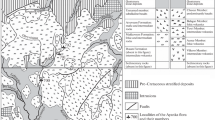Abstract
The Namyang flora and the initial palaeoenvironmental implications of the Late Miocene Kocham Formation in North Hamgyong Province, northern DPRK, are discussed based on gross morphology. The Namyang megafossil beds are tuffaceous lacustrine deposits consisting mainly of diatomites intercalating with eruptive deposits. The Namyang fossil plant assemblage consists of 31 taxa belonging to 12 families and 20 genera, which was dominated by deciduous angiosperms. The dominant taxa were Zelkova, Fagus, Betula, Tilia, Juglans, Carpinus, and Acer. Spores and pollen data resemble the vegetation type as reflected by macrofossils, though differences exist between macrofossils and pollen records. The Namyang flora is comparable with the modern mixed mesophytic formation in a warm temperate climatic condition from the paleobotanic data. The upper Miocene Namyang flora represents a major resource for Cenozoic continental paleoclimatic interpretations.







Similar content being viewed by others
References
Academia Sinica (1978) Cenozoic plant of China. Scientific Publishing House, Bei**g (in Chinese)
Barrón E, Averyanova A, Kvaček Z, Momohara A, Pigg KB, Popova S, Postigo-Mijarra JM, Tiffney BH, Utescher T, Zhou ZK (2017) The fossil history of Quercus. In: Gil-Pelegrín E, Peguero-Pina JJ, Sancho-Knapik D (eds) Oaks physiological ecology. Exploring the functional diversity of genus Quercus L. Springer, Chambridge, pp 39–105
Bradbury JP, Dieterich KV, Williams JL (1985) Diatom flora of the Miocene lake beds near Clarkia in northern Idaho. In: Smiley CJ (ed) Late Cenozoic history of the Pacific Northwest. Pacific Division of the American Association for the Advancement of Science, San Francisco, pp 33–60
Ferguson DK (1985) The origin of leaf-assemblages-new light on an old problem. Rev Palaeobot Palynol 46:117–188
Ferguson DK (2005) Plant taphonomy: ruminations of the past, the present, and the future. Palaios 20:418–428
Hu HH, Chaney RW (1940) A Miocene flora from Shantung Province, China. Palaeontologia sinica, New Ser A, pp 1–112
Jiang B, Fürsich FT, Sha J, Wang B, Niu Y (2011) Early Cretaceous volcanism and its impact on fossil preservation in Western Liaoning, NE China. Palaeogeogr Palaeoclimatol Palaeoecol 302:255–269
Jo IW, Pak U (1996) Cenozoic Era. In: Paek RJ, Kang HG, Jon GP (Eds.), Geology of Korea. Foreign Languages Books Publishing House, Pyongyang, pp 155–188
Kovar-Eder J, Sun G (2009) The Neogene flora from Badaogou of Changbai, NE China-Most similar living relatives of selected taxa and relations to the European record. Rev Palaeobot Palynol 158:1–13
Li HM (1982) The age of Shanwang flora. In: Palaeontological Society of China (Editor)–Selected Papers from the 12th Annual Convention of Paleontological Society of China, Scientific Publishing House (in Chinese), pp 158–162
Martín-Closas C, Gomez B (2004) Plant taphonomy and palaeoecological interpretations. A synthesis. Geobios 37:65–88
Martín-Closas C, Permanyer A, Vila M (2005) Palynofacies distribution in a lacustrine basin. Geobios 38:197–210
Spicer RA (1981) The sorting and deposition of allochtonous plant materials in a modern environment at Silwood Lake, Silwood Park, Berkenshire, England.United States Geological Survey Professional Paper, vol. 1143, pp 1–77
Sun QG, Collinson ME, Li ChS, Wang YF, Beerling DJ (2002) Quantitative reconstruction of palaeoclimate from the Middle Miocene Shanwang fora, eastern China. Palaeogeogr Palaeoclimatol Palaeoecol 180:315–329
Sze XJ (1951) Review of Hu, H.H. & R.W. Chaney’s “A Miocene flora from Shantung Province, China.” Sci Sin 2:245–252 (in Chinese)
Traverse A (2007) Paleopalynology, 2nd edn. Springer, Dordrecht, pp 1–813
Uemura K (1983) Late Neogene Liquidambar (Hamamelidaceae) from the southern part of northeast Honshu, Japan. Mem Nat Sci Mus Tokyo 16:25–36
Veatch SW, Meyer HW (2008) History of paleontology at the Florissant fossil beds, Colorado. In: Myer HW, Smith DM (Eds.), The Geological Society of America Special Paper, vol. 435, pp 1–18
Wing SL, Greenwood DR (1993) Fossil and fossil climate: the case for equable continental interiors in the Eocene. Phil Trans r Soc Lond B 341:243–252
Wolfe JA (1979) Temperature parameters of humid to mesic forests of other region of the Northern Hemisphere and Australia. United States Geological Survey Prof Paper, vol 1106, pp 1–37
Yang H (1996) Comparison of Miocene fossil floras in lacustrine deposits Implications for palaeoclimatic interpretations at the middle latitudes of the Pacific rim. Palaeobotanist 45:416–429
Yang H, Yang P (1994) The Shanwang fossil biota in eastern China: a Miocene Konservat-Lagerstätte in lacustrine deposits. Lethaia 27:345–354
Yang H (1988) The Miocene Shanwang flora and its paleoclimatology from Shandong, China. M.S. Thesis, China Universiry of Geosciences (Bei**g) (in Chinese with English summary)
Acknowledgements
We offer our sincere gratitude to Jong-Rim Kwon for their contribution to the knowledge of the Tertiary fossil plant. The authors are deeply grateful to Johanna Kovar-Eder (State Museum of Natural History Stuttgart, Germany) for revision of the original manuscript, valuable consultations, and practical help. Our sincere gratitude is also offered to reviewer for improvement and correction and Editor-in-Chief and Editor for editorial help.
Author information
Authors and Affiliations
Corresponding author
Ethics declarations
Conflict of interest
The authors declare no competing interests.
Additional information
Responsible Editor: Attila Ciner
Rights and permissions
Springer Nature or its licensor (e.g. a society or other partner) holds exclusive rights to this article under a publishing agreement with the author(s) or other rightsholder(s); author self-archiving of the accepted manuscript version of this article is solely governed by the terms of such publishing agreement and applicable law.
About this article
Cite this article
Kim, MS., Kim, JK., An, KI. et al. The upper Miocene Namyang flora of the Democratic People’s Republic of Korea: preliminary implication for palaeoclimatic interpretation. Arab J Geosci 17, 130 (2024). https://doi.org/10.1007/s12517-024-11935-2
Received:
Accepted:
Published:
DOI: https://doi.org/10.1007/s12517-024-11935-2



